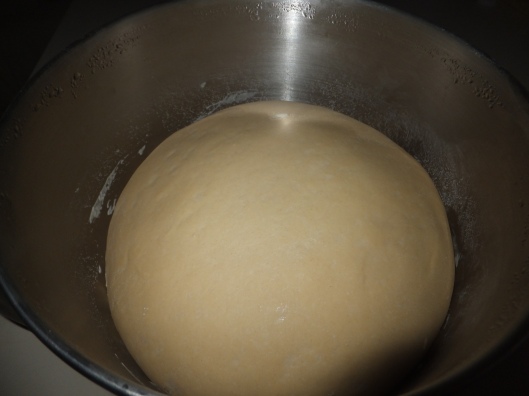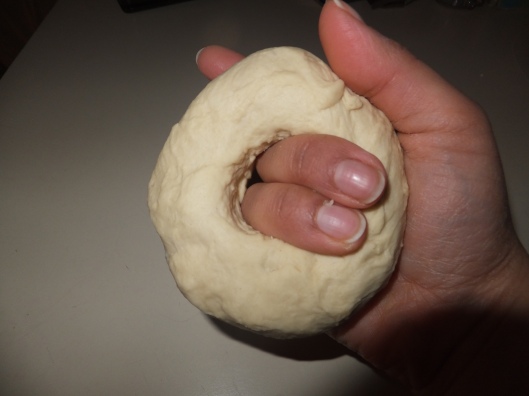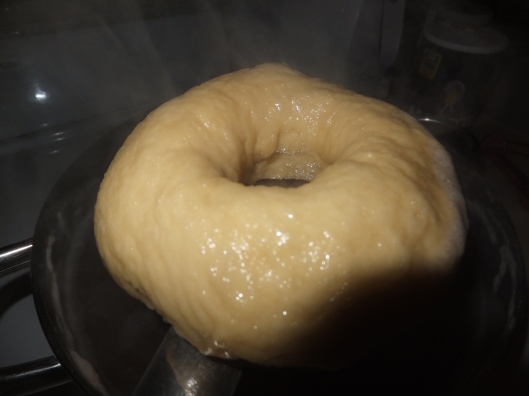Surprisingly, people always find it surprising that I make my own bagels. However, for both veteran and novice bakers, bagels are among the easier yeasted breads to make. The process is both incredibly foolproof and fun.
You may never want to buy bagels again once you try these. It’s about a 3-4 hour process (with a lot of waiting time) but you can spread it out over two days. Slice and freeze any leftovers for a convenient breakfast treat!
One note – barley malt syrup, while optional, does give a delightful flavor and color, especially to the crust. I’ve seen it at Whole Foods as well as TPSS Co-op and other health food stores.
Bagels (adapted from the fabulous Peter Reinhart’s post on Leite’s Culinaria)
Dough
2 tablespoons barley malt syrup, honey, or rice syrup, or 2 teaspoons diastatic malt powder
2 teaspoons instant yeast
1 tablespoon salt, or 5 teaspoons coarse kosher salt
2 1/4 cups lukewarm water (about 95°F)
7-8 cups (16 oz / 454 g) unbleached bread flour
Poaching liquid
1/2 to 3/4 gallon water (enough to fill a big pot with 2 inches of room at the top)
1 1/2 tablespoons barley malt syrup or honey
1 tablespoon baking soda
1 teaspoon salt, or 1 1/2 teaspoons coarse kosher salt
Mixing the dough is easiest with a stand mixer or bread machine, but can definitely be done by hand (with the benefit of stress-relief). If you’re using a mixer or bread machine, just put all the dough ingredients (but only 7 of the 8 cups of flour) in there and mix/knead, adding more flour as necessary, until you have a smooth, rather stiff, non-sticky dough. If you’re doing it by hand, mix the dry ingredients together in a large bowl, make a hole in the center and add the wet ingredients. Stir with a wooden spoon until you can’t stir anymore, then get in there with your hands and KNEAD that dough. When it becomes a ball, turn it out onto a floured surface and knead, adding flour as necessary. At the end of all of this, it should look like a satiny-smooth ball of awesome.
At this point I put the dough in a big bowl, cover with plastic wrap and put it in the fridge to rise overnight so I can make fresh bagels in the morning. Otherwise, just let the dough rise at room temperature for one hour.
Cover two baking sheets with parchment paper and lightly oil it. Divide the dough into ten equal pieces (I use my beloved kitchen scale for this). Take each ball of dough and choke it on one end with your thumb and index finger, then stuff the rest of the dough into the little balloon you’ve made.
Poke a hole through the center of the ball to create a donut shape. Holding the dough with both thumbs in the hole, rotate the dough with your hands, gradually stretching it to create a hole about 2 inches in diameter. The hole will get smaller during boiling and baking. I also found this guide to be pretty helpful.
Reinhart now wants you let the bagels rise again, but I like mine dense and chewy so I don’t. If you want to, just cover them with a damp tea towel and leave at room temperature for about half an hour.
Preheat your oven to 450°F. Mix poaching liquid in large pot and bring just to a boil. Drop the bagels, two or three at a time, into the liquid and allow to simmer about one minute on each side. Transfer back to the baking sheets with a slotted spoon.
Bake for 8 minutes, then carefully flip each bagel over, rotate the pans and bake another 8-12 minutes.
Cool on a wire rack for at least 30 minutes (or as long as you can stand it) before slicing or serving. Makes 10 bagels.


![DSCF0336[1]](https://dcvegetarian.files.wordpress.com/2013/03/dscf03361.jpg?w=529&h=396)


![DSCF0311[1]](https://dcvegetarian.files.wordpress.com/2013/03/dscf03111.jpg?w=529&h=396)


![DSCF0331[1]](https://dcvegetarian.files.wordpress.com/2013/03/dscf03311.jpg?w=529&h=396)
నీడుతున్నాను …
Haha well let’s make some then!
ఎప్పుడు???!!!!
నేను కూడా నీడుతున్నాను!!!!!!
Actually cooking process నీడుతున్నాను. Kani bagel kuda wantuthunanu. 🙂
The cooking process is fun! You’ll like the boiling part. I think I wasn’t much older than you when I started making bread by myself!
Yes! We did it!
Pingback: Baking bread at home | Ask Amma